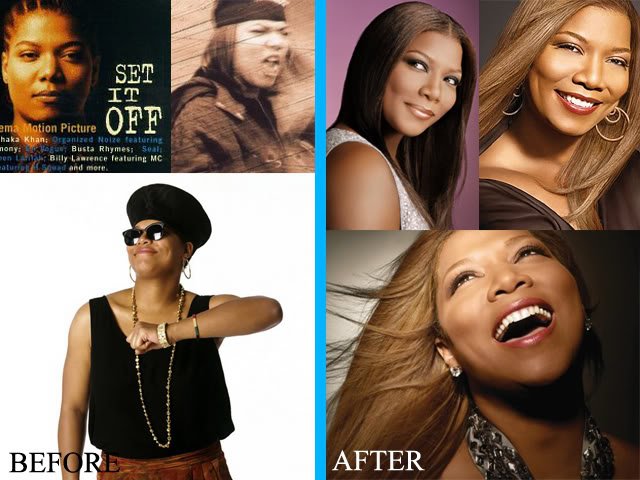

Queen Latifah is another female singer and actor who has been famous amongst the African-American community since the 1990s. Towards the beginning of her career, she appeared in magazines as embracing her roots (the images on the left side). Latifah's image on the top left reveals her having a dark skin tone. Latifah is wearing her hair in cornrows and these braids typically symbolize the idea of embracing the African-American culture, rebelling against the pressures of appearing white through chemically relaxing the hair to make it appear more silky and straight. In the images next to Latifah wearing her hair in cornrows, Latifah is revealed as participating in the Hip-Hop culture. The image that is to the right of the "Set It Off" image, Latifah is rapping and appears to be putting a lot of emotion into what she is saying. The hoodie that she is wearing is also a part of the identity that makes up Hip-Hop culture. Latifah's choice of clothing and facial expression reveals her performativity of being a Hip-Hop singer. The bottom large picture of Latifah shows Latifah dancing. Dance is a large part of Hip-Hop culture. It allows people to come together and engage in a fun activity where they can express feelings, engage in exercise and be entertainmented. Hip-hop is extremely popular in the African-American community and is a genre of music that African-Americans dominate. These images reveal her embracing her identity related to Hip-Hop, being an African-American and essentially performing these roles.
Currently in the 2010s, the makeup brand Covergirl has used Latifah to advertise their products. In the images to the right side that say "after" are Latifah's images of her advertising Covergirl makeup. Latifah has light brown hair and appears extremely feminine compared to her "before" images. Latifah is now shown wearing makeup, obviously since she is advertising a makeup brand. It is interesting to see Latifah's complete change in style and this leads us to the idea of performativity which is a learned behavior. Currently in 2012, it is not as acceptable and appealing for a female celebrity to appear as Latifah did in her "before" pictures. Latifah's old performance of identity revealed her as embracing her roots and being a part of the hip-hop movement. Latifah's new images reveal her as non-threatening and rather passive. The lighting in the images makes Latifah appear as if she has a slight glow to her. The close-up camera shots of her give the audience a more personal feel. The images of her looking away from the camera reveal Latifah as passive.
According to Treva Lindsey, author of "Black No More: Skin Bleaching and the Emergence of New Negro Womanhood Beauty Culture," "African American-beauty culture is unfolded and evolved on the pages of newspapers and journals; the majority of advertisements encourage black women to look more like their white or bi-racial female counterparts" (103). This leads us into a discourse analysis of what beauty is. Discourse "is a particular knowledge about the world which shapes how the world is understood and how things are done in it" (Rose 142). While looking at Latifah's recent images it appears that she has done a complete flip with her performativity and is now "in touch" with her feminine side. Tracey Patton, author of "Hey girl, am I more than my Hair?: African American Women and their Struggles with Beauty, body image, and Hair," "beauty is subject to the hegemonic standards of the ruling class" (25). This means that in the American culture, what the dominant white society calls beauty is what everyone follows and does their best to achieve. It can be inferred that Latifah is buying into the beauty myth; the beauty myth that consists of European features such as having light colored hair and skin, and straight hair. European features are normalized and naturalized ideals in the beauty myth. Covergirl's portrayal of Latifah makes Latifah appear as if she is buying into the myth because of her transformation in appearance. Latifah in the 1990s had more of a male-styled appearance and was seen wearing very little to no makeup. Currently Latifah is seen wearing a face full of makeup, her hair is dyed light brown and straightened.
Latifah has conformed to the ideals of what the dominant society says a woman should look like to qualify as beautiful. Aside from following the beauty myth, Latifah is also performing the stereotypical role of a female. It is said that it is the "man's role" to provide for his family, appear intimidating and be masculine. It is said that it is a "woman role" to look pretty, be passive, and cater to the man. Latifah is not necessarily following this description but with her drastic change in appearance, the audience can infer that something is going on in her life to where she wanted a change. Latifah's image before represented being loud, speaking out, embracing her culture and appearing tough. Her new images in the Covergirl ad take away from her old appearance and make her appear as pretty, silent and passive. This new image that Latifah has taken on appears as if it is because she is now promoting Covergirl makeup. This reveals to African-American females that if they want to "look beautiful" and model makeup, then they too should alter their appearance in the same way how Latifah has altered hers. Just as seen in the L'Oreal ad, advertisements continue to send out messages that the closer one looks to European, the more attractive they are.